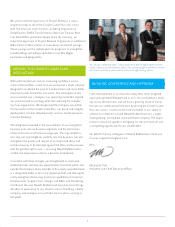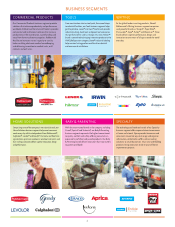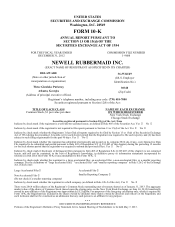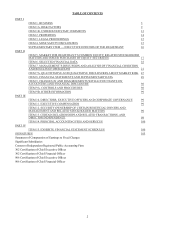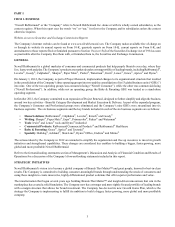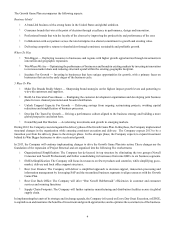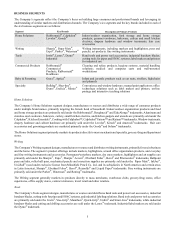Graco 2012 Annual Report Download - page 15
Download and view the complete annual report
Please find page 15 of the 2012 Graco annual report below. You can navigate through the pages in the report by either clicking on the pages listed below, or by using the keyword search tool below to find specific information within the annual report.9
Environmental Matters
Information regarding the Company’s environmental matters is included in the Management’s Discussion and Analysis of Financial
Condition and Results of Operations section of this report and in Footnote 20 of the Notes to Consolidated Financial Statements
and is incorporated by reference herein.
Research and Development
Information regarding the Company’s research and development costs for each of the past three years is included in Footnote 1
of the Notes to Consolidated Financial Statements and is incorporated by reference herein. The Company’s research and
development costs are incurred to develop new, differentiated and innovative products to meet consumers’ needs.
Employees
As of December 31, 2012, the Company had approximately 18,300 employees worldwide, of whom approximately 2,200 are
covered by collective bargaining agreements or are located in countries that have collective arrangements decreed by statute.
ITEM 1A. RISK FACTORS
The factors that are discussed below, as well as the matters that are generally set forth in this report on Form 10-K and the documents
incorporated by reference herein, could materially and adversely affect the Company’s business, results of operations and financial
condition.
The Company is subject to risks related to its dependence on the strength of retail, commercial and industrial sectors of
the economy in various parts of the world.
The Company's business depends on the strength of the retail, commercial and industrial sectors of the economy in various parts
of the world, primarily in North America, and to a lesser extent Europe, Central and South America, and Asia. These sectors of
the economy are affected primarily by factors such as consumer demand and the condition of the retail industry, which, in turn,
are affected by general economic conditions. With continuing challenging and volatile economic conditions in the U.S., Western
Europe and elsewhere, there has been considerable pressure on consumer demand, and the resulting impact on consumer spending
has had and may continue to have an adverse effect on demand for the Company's products as well as its financial condition and
results of operations. The Company could also be negatively impacted by economic crises in specific countries or regions, including
the deterioration in the creditworthiness of, or a default by, the issuers of sovereign debt. Such events could negatively impact the
Company's overall liquidity and/or create significant credit risks relative to its local customers and depository institutions. Consumer
demand and the condition of these sectors of the economy may also be impacted by other external factors such as war, terrorism,
geopolitical uncertainties, public health issues, natural disasters and other business interruptions. The impact of these external
factors is difficult to predict, and one or more of the factors could adversely impact the Company's business.
The Company is subject to intense competition in a marketplace dominated by large retailers and e-commerce companies.
The Company competes with numerous other manufacturers and distributors of consumer and commercial products, many of
which are large and well-established. The Company's principal customers are large mass merchandisers, such as discount stores,
home centers, warehouse clubs, office superstores, commercial distributors and e-commerce companies. The rapid growth of these
large mass merchandisers, together with changes in consumer shopping patterns, have contributed to the formation of dominant
multi-category retailers and e-commerce companies that have strong negotiating power with suppliers. Current trends among
retailers and e-commerce companies include fostering high levels of competition among suppliers, demanding innovative new
products and requiring suppliers to maintain or reduce product prices, and delivering products with shorter lead times. Other trends
are for retailers and e-commerce companies to import products directly from foreign sources and to source and sell products, under
their own private label brands, that compete with the Company's products.
The combination of these market influences and retailer consolidation has created an intensely competitive environment in which
the Company's principal customers continuously evaluate which product suppliers to use, resulting in downward pricing pressures
and the need for big, consumer-meaningful brands, the ongoing introduction and commercialization of innovative new products,
continuing improvements in category management and customer service, and the maintenance of strong relationships with large,
high-volume purchasers. The Company also faces the risk of changes in the strategy or structure of its major customers, such as
overall store and inventory reductions and consolidation. The intense competition in the retail and e-commerce sectors, combined
with the overall economic environment, may result in a number of customers experiencing financial difficulty or failing in the
future. In particular, a failure by one of the Company's large customers would adversely impact the Company's sales and operating
cash flows. As a result of these factors, the Company may experience a loss of sales, reduced profitability and a limited ability
to recover cost increases through price increases.


